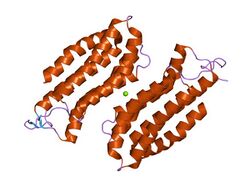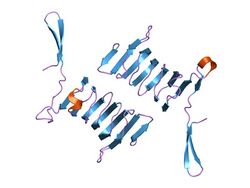Biology:Cyclase-associated protein family
| CAP N-terminal | |||||||||
|---|---|---|---|---|---|---|---|---|---|
 structure of the n-terminal domain of the adenylyl cyclase-associated protein (cap) from dictyostelium discoideum. | |||||||||
| Identifiers | |||||||||
| Symbol | CAP_N | ||||||||
| Pfam | PF01213 | ||||||||
| InterPro | IPR013992 | ||||||||
| PROSITE | PDOC00835 | ||||||||
| SCOP2 | 1s0p / SCOPe / SUPFAM | ||||||||
| |||||||||

| CAP C-terminal | |||||||||
|---|---|---|---|---|---|---|---|---|---|
 c-terminal domain of cyclase associated protein with pro 505 replaced by ser (p505s) | |||||||||
| Identifiers | |||||||||
| Symbol | CAP_C | ||||||||
| Pfam | PF08603 | ||||||||
| Pfam clan | CL0391 | ||||||||
| InterPro | IPR013912 | ||||||||
| PROSITE | PDOC00835 | ||||||||
| SCOP2 | 1kq5 / SCOPe / SUPFAM | ||||||||
| |||||||||
In molecular biology, the cyclase-associated protein family (CAP) is a family of highly conserved actin-binding proteins present in a wide range of organisms including yeast, flies, plants, and mammals. CAPs are multifunctional proteins that contain several structural domains. CAP is involved in species-specific signalling pathways.[2][3][4][5] In Drosophila, CAP functions in Hedgehog-mediated eye development and in establishing oocyte polarity. In Dictyostelium discoideum (social amoeba), CAP is involved in microfilament reorganisation near the plasma membrane in a PIP2-regulated manner and is required to perpetuate the cAMP relay signal to organise fruitbody formation. In plants, CAP is involved in plant signalling pathways required for co-ordinated organ expansion. In yeast, CAP is involved in adenylate cyclase activation, as well as in vesicle trafficking and endocytosis. In both yeast and mammals, CAPs appear to be involved in recycling G-actin monomers from ADF/cofilins for subsequent rounds of filament assembly.[6][7] In mammals, there are two different CAPs (CAP1 and CAP2) that share 64% amino acid identity.
Function
All CAPs appear to contain a C-terminal actin-binding domain that regulates actin remodelling in response to cellular signals and is required for normal cellular morphology, cell division, growth and locomotion in eukaryotes. CAP directly regulates actin filament dynamics and has been implicated in a number of complex developmental and morphological processes, including mRNA localisation and the establishment of cell polarity. Actin exists both as globular (G) (monomeric) actin subunits and assembled into filamentous (F) actin. In cells, actin cycles between these two forms. Proteins that bind F-actin often regulate F-actin assembly and its interaction with other proteins, while proteins that interact with G-actin often control the availability of unpolymerised actin.
The most conserved domain of CAPs appears to be the ADP-G-actin binding CARP domain which promotes nucleotide exchange of actin monomers from ADP-state back to polymerisable ATP-form.[8] Recently, the crystal structure of CARP domain bound to ADP-actin was determined, which revealed that CAPs have a unique dimeric binding mode to backside of ADP-G-actin monomers.[1] Based on the crystal structure and biochemical work, the C-terminus of CARP domain appears to be important in regulating the binding to ADP-G-actin monomers to CAP, and has a conserved role for nucleotide exchange on actin monomers. Genetic work in Saccharomyches ceravisae revealed that nucleotide exchange performed by CAP is critical for normal organisation of actin cytoskeleton.
A second unique function of CAP in regulating actin dynamics is its ability to specifically bind to pointed ends of cofilin-decorated actin filaments,[9] and rapidly drive their depolymerisation.[9][10] CAP thus is a specialised protein in recycling of actin monomers, by first rapidly dissociating ADP-actin monomers from the pointed end of actin filaments, then simultaneously driving ADP-to-ATP nucleotide exchange to make actin monomers assembly-competent.
In addition to actin-binding, CAPs can have additional roles, and may act as bifunctional proteins. In Saccharomyces cerevisiae (Baker's yeast), CAP is a component of the adenylyl cyclase complex (Cyr1p) that serves as an effector of Ras during normal cell signalling. S. cerevisiae CAP functions to expose adenylate cyclase binding sites to Ras, thereby enabling adenylate cyclase to be activated by Ras regulatory signals. In Schizosaccharomyces pombe (Fission yeast), CAP is also required for adenylate cyclase activity, but not through the Ras pathway. In both organisms, the N-terminal domain is responsible for adenylate cyclase activation, but the S. cerevisiae and S. pombe N-termini cannot complement one another. Yeast CAPs are unique among the CAP family of proteins, because they are the only ones to directly interact with and activate adenylate cyclase.[11] S. cerevisiae CAP has four major domains. In addition to the N-terminal adenylate cyclase-interacting domain, and the C-terminal actin-binding domain, it possesses two other domains: a proline-rich domain that interacts with Src homology 3 (SH3) domains of specific proteins, and a domain that is responsible for CAP oligomerisation to form multimeric complexes (although oligomerisation appears to involve the N- and C-terminal domains as well). The proline-rich domain interacts with profilin, a protein that catalyses nucleotide exchange on G-actin monomers and promotes addition to barbed ends of filamentous F-actin.[6] Since CAP can bind profilin via a proline-rich domain, and G-actin via a C-terminal domain, it has been suggested that a ternary G-actin/CAP/profilin complex could be formed.
Structure
The N-terminal domain has an all-alpha structure consisting of six helices in a bundle with a left-handed twist and an up-and-down topology.[12]
The C-terminal domain is responsible for G-actin-binding. This domain has a superhelical structure, where the superhelix turns are made of two beta-strands each.[13]
References
- ↑ 1.0 1.1 "Structural basis of actin monomer re-charging by cyclase-associated protein". Nature Communications 9 (1): 1892. May 2018. doi:10.1038/s41467-018-04231-7. PMID 29760438. Bibcode: 2018NatCo...9.1892K.
- ↑ "Cyclase-associated proteins: CAPacity for linking signal transduction and actin polymerization". FASEB Journal 16 (6): 487–99. April 2002. doi:10.1096/fj.01-0659rev. PMID 11919151.
- ↑ "Arabidopsis CAP1 - a key regulator of actin organisation and development". Journal of Cell Science 120 (Pt 15): 2609–18. August 2007. doi:10.1242/jcs.007302. PMID 17635992.
- ↑ "Mammalian homolog of the yeast cyclase associated protein, CAP/Srv2p, regulates actin filament assembly". Cell Motility and the Cytoskeleton 45 (2): 106–20. February 2000. doi:10.1002/(SICI)1097-0169(200002)45:2<106::AID-CM3>3.0.CO;2-3. PMID 10658207.
- ↑ "Crystallization of cyclase-associated protein from Dictyostelium discoideum". Acta Crystallographica D 58 (Pt 10 Pt 2): 1858–61. October 2002. doi:10.1107/S0907444902013306. PMID 12351838. Bibcode: 2002AcCrD..58.1858H.
- ↑ 6.0 6.1 "Mechanism and biological role of profilin-Srv2/CAP interaction". Journal of Cell Science 120 (Pt 7): 1225–34. April 2007. doi:10.1242/jcs.000158. PMID 17376963.
- ↑ "Cyclase-associated protein 1 (CAP1) promotes cofilin-induced actin dynamics in mammalian nonmuscle cells". Molecular Biology of the Cell 15 (5): 2324–34. May 2004. doi:10.1091/mbc.E04-01-0048. PMID 15004221.
- ↑ "Human CAP1 is a key factor in the recycling of cofilin and actin for rapid actin turnover". Journal of Cell Science 115 (Pt 8): 1591–601. April 2002. doi:10.1242/jcs.115.8.1591. PMID 11950878.
- ↑ 9.0 9.1 "Mechanism of synergistic actin filament pointed end depolymerization by cyclase-associated protein and cofilin". Nature Communications 10 (1): 5320. 22 November 2019. doi:10.1038/s41467-019-13213-2. PMID 31757941. Bibcode: 2019NatCo..10.5320K.
- ↑ "Synergy between Cyclase-associated protein and Cofilin accelerates actin filament depolymerization by two orders of magnitude". Nature Communications 10 (1): 5319. 22 November 2019. doi:10.1038/s41467-019-13268-1. PMID 31757952. Bibcode: 2019NatCo..10.5319S.
- ↑ "Association of yeast adenylyl cyclase with cyclase-associated protein CAP forms a second Ras-binding site which mediates its Ras-dependent activation". Molecular and Cellular Biology 20 (1): 26–33. January 2000. doi:10.1128/mcb.20.1.26-33.2000. PMID 10594005.
- ↑ "Structure of the N-terminal domain of the adenylyl cyclase-associated protein (CAP) from Dictyostelium discoideum". Structure 11 (9): 1171–8. September 2003. doi:10.1016/S0969-2126(03)00180-1. PMID 12962635.
- ↑ "Crystal structure of the actin binding domain of the cyclase-associated protein". Biochemistry 43 (33): 10628–41. August 2004. doi:10.1021/bi049071r. PMID 15311924.
 |

